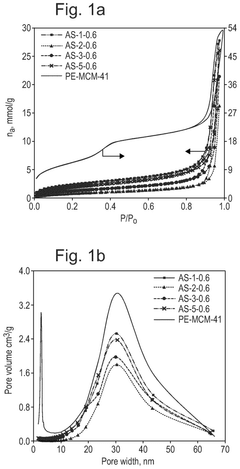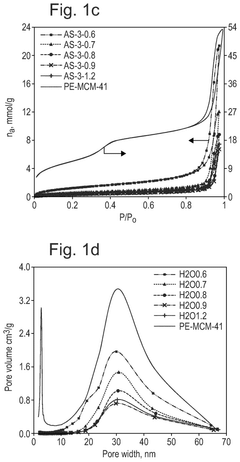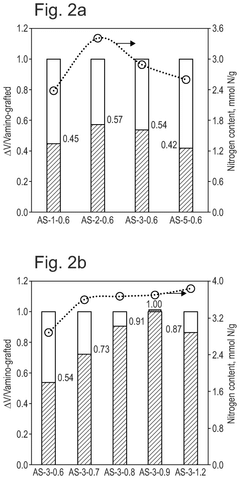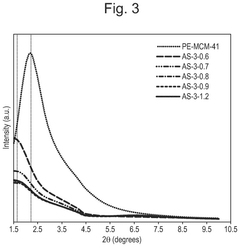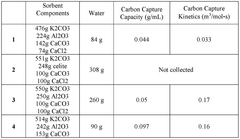How Regulations Shape Carbon Capture Sorbent Technologies
OCT 21, 20259 MIN READ
Generate Your Research Report Instantly with AI Agent
Patsnap Eureka helps you evaluate technical feasibility & market potential.
Carbon Capture Regulatory Background and Objectives
Carbon capture technologies have evolved significantly over the past three decades, driven primarily by increasing global concerns about climate change and the subsequent regulatory frameworks established to mitigate carbon emissions. The initial regulatory foundations for carbon capture emerged in the 1990s following the United Nations Framework Convention on Climate Change (UNFCCC), which set the stage for international cooperation on emission reductions. This was further strengthened by the Kyoto Protocol in 1997 and more recently by the Paris Agreement in 2015, which established more ambitious targets for limiting global temperature increases.
The technical evolution of carbon capture sorbent technologies has been closely intertwined with these regulatory developments. Early carbon capture systems focused primarily on post-combustion capture using amine-based solvents, which, while effective, presented challenges related to energy consumption and solvent degradation. As regulations tightened, particularly in regions like the European Union with its Emissions Trading System (EU ETS) and in North America with various state and federal initiatives, the demand for more efficient and cost-effective capture technologies intensified.
The primary objective of current carbon capture technology development is to achieve significant reductions in capture costs while maintaining or improving capture efficiency. Current targets set by organizations such as the U.S. Department of Energy aim for capture costs below $40 per ton of CO2 by 2025 and below $30 per ton by 2035, representing substantial improvements over current costs that often exceed $60-100 per ton.
Regulatory frameworks have increasingly incorporated performance-based standards rather than prescriptive approaches, allowing for greater innovation in sorbent technologies. This shift has encouraged the development of novel materials such as metal-organic frameworks (MOFs), zeolites, and advanced polymer membranes, each offering potential advantages in selectivity, capacity, and regeneration energy requirements.
Recent regulatory trends indicate a move toward more comprehensive carbon management strategies, including carbon pricing mechanisms, tax incentives for carbon capture deployment, and direct subsidies for research and development. The 45Q tax credit in the United States, enhanced under the Inflation Reduction Act of 2022, provides up to $85 per metric ton for CO2 captured and sequestered, significantly improving the economic viability of carbon capture projects.
Looking forward, the technical trajectory of carbon capture sorbent technologies will likely be shaped by increasingly stringent emission reduction targets, particularly as countries work toward their nationally determined contributions under the Paris Agreement and pursue net-zero emission goals by mid-century. This regulatory pressure is expected to accelerate innovation in next-generation sorbents that offer improved performance metrics across capture efficiency, energy consumption, and operational stability.
The technical evolution of carbon capture sorbent technologies has been closely intertwined with these regulatory developments. Early carbon capture systems focused primarily on post-combustion capture using amine-based solvents, which, while effective, presented challenges related to energy consumption and solvent degradation. As regulations tightened, particularly in regions like the European Union with its Emissions Trading System (EU ETS) and in North America with various state and federal initiatives, the demand for more efficient and cost-effective capture technologies intensified.
The primary objective of current carbon capture technology development is to achieve significant reductions in capture costs while maintaining or improving capture efficiency. Current targets set by organizations such as the U.S. Department of Energy aim for capture costs below $40 per ton of CO2 by 2025 and below $30 per ton by 2035, representing substantial improvements over current costs that often exceed $60-100 per ton.
Regulatory frameworks have increasingly incorporated performance-based standards rather than prescriptive approaches, allowing for greater innovation in sorbent technologies. This shift has encouraged the development of novel materials such as metal-organic frameworks (MOFs), zeolites, and advanced polymer membranes, each offering potential advantages in selectivity, capacity, and regeneration energy requirements.
Recent regulatory trends indicate a move toward more comprehensive carbon management strategies, including carbon pricing mechanisms, tax incentives for carbon capture deployment, and direct subsidies for research and development. The 45Q tax credit in the United States, enhanced under the Inflation Reduction Act of 2022, provides up to $85 per metric ton for CO2 captured and sequestered, significantly improving the economic viability of carbon capture projects.
Looking forward, the technical trajectory of carbon capture sorbent technologies will likely be shaped by increasingly stringent emission reduction targets, particularly as countries work toward their nationally determined contributions under the Paris Agreement and pursue net-zero emission goals by mid-century. This regulatory pressure is expected to accelerate innovation in next-generation sorbents that offer improved performance metrics across capture efficiency, energy consumption, and operational stability.
Market Demand Analysis for Carbon Capture Solutions
The global carbon capture market is experiencing unprecedented growth, driven primarily by stringent environmental regulations and increasing corporate commitments to carbon neutrality. Current market assessments value the carbon capture, utilization, and storage (CCUS) sector at approximately $2.5 billion in 2022, with projections indicating expansion to reach $7.0 billion by 2030, representing a compound annual growth rate of 13.8%.
Industrial sectors, particularly cement, steel, and power generation, constitute the largest demand segment for carbon capture technologies. These heavy industries contribute nearly 40% of global CO2 emissions and face mounting regulatory pressure to decarbonize operations. The International Energy Agency estimates that CCUS technologies must capture more than 1 billion tonnes of CO2 annually by 2030 to align with Paris Agreement targets, compared to current capacity of roughly 40 million tonnes.
Regional market analysis reveals significant variations in demand patterns. Europe leads in regulatory frameworks promoting carbon capture adoption, with the EU Emissions Trading System creating economic incentives through carbon pricing mechanisms that have reached €80-90 per tonne. North America follows with substantial government investment, exemplified by the U.S. Inflation Reduction Act allocating $369 billion toward climate initiatives including enhanced tax credits for carbon capture projects.
Emerging economies, particularly China and India, represent rapidly growing markets despite less developed regulatory frameworks. China's recent inclusion of CCUS in its 14th Five-Year Plan signals strong future demand growth in the region, potentially creating the world's largest carbon capture market by volume within the decade.
Customer segmentation analysis identifies three primary market segments: large industrial emitters seeking compliance solutions, energy companies pursuing enhanced oil recovery applications, and forward-looking corporations implementing voluntary carbon reduction strategies to meet ESG commitments. The first segment currently dominates market share but the third shows the highest growth rate at 22% annually.
Market barriers include high implementation costs, with current carbon capture solutions adding 50-70% to operational expenses in many applications. This cost barrier creates significant demand for more efficient sorbent technologies that can reduce energy penalties and capital requirements. Industry surveys indicate willingness to adopt solutions that can demonstrate capture costs below $50 per tonne, highlighting the critical price threshold for widespread market penetration.
The regulatory landscape directly shapes technology requirements, with different jurisdictions emphasizing varying performance metrics. European regulations prioritize capture efficiency (minimum 90%), while North American frameworks emphasize cost-effectiveness and operational flexibility, creating distinct regional technology preferences.
Industrial sectors, particularly cement, steel, and power generation, constitute the largest demand segment for carbon capture technologies. These heavy industries contribute nearly 40% of global CO2 emissions and face mounting regulatory pressure to decarbonize operations. The International Energy Agency estimates that CCUS technologies must capture more than 1 billion tonnes of CO2 annually by 2030 to align with Paris Agreement targets, compared to current capacity of roughly 40 million tonnes.
Regional market analysis reveals significant variations in demand patterns. Europe leads in regulatory frameworks promoting carbon capture adoption, with the EU Emissions Trading System creating economic incentives through carbon pricing mechanisms that have reached €80-90 per tonne. North America follows with substantial government investment, exemplified by the U.S. Inflation Reduction Act allocating $369 billion toward climate initiatives including enhanced tax credits for carbon capture projects.
Emerging economies, particularly China and India, represent rapidly growing markets despite less developed regulatory frameworks. China's recent inclusion of CCUS in its 14th Five-Year Plan signals strong future demand growth in the region, potentially creating the world's largest carbon capture market by volume within the decade.
Customer segmentation analysis identifies three primary market segments: large industrial emitters seeking compliance solutions, energy companies pursuing enhanced oil recovery applications, and forward-looking corporations implementing voluntary carbon reduction strategies to meet ESG commitments. The first segment currently dominates market share but the third shows the highest growth rate at 22% annually.
Market barriers include high implementation costs, with current carbon capture solutions adding 50-70% to operational expenses in many applications. This cost barrier creates significant demand for more efficient sorbent technologies that can reduce energy penalties and capital requirements. Industry surveys indicate willingness to adopt solutions that can demonstrate capture costs below $50 per tonne, highlighting the critical price threshold for widespread market penetration.
The regulatory landscape directly shapes technology requirements, with different jurisdictions emphasizing varying performance metrics. European regulations prioritize capture efficiency (minimum 90%), while North American frameworks emphasize cost-effectiveness and operational flexibility, creating distinct regional technology preferences.
Global Sorbent Technology Landscape and Barriers
Carbon capture sorbent technologies are developing at varying rates globally, influenced by regional regulatory frameworks, research funding, and industrial priorities. In North America, the focus has been on post-combustion capture technologies, with significant advancements in amine-based solid sorbents and metal-organic frameworks (MOFs). The United States Department of Energy has invested heavily in research programs targeting cost reduction for carbon capture technologies, establishing a competitive landscape for innovative sorbent development.
The European Union presents a different technological landscape, with stricter emissions regulations driving rapid adoption of advanced sorbent technologies. European research institutions have pioneered zeolite-based materials and functionalized porous polymers, achieving higher CO2 selectivity under industrial conditions. The EU's Emissions Trading System has created economic incentives that have accelerated commercial deployment of these technologies, particularly in the power generation and cement manufacturing sectors.
In Asia, particularly China and Japan, development has focused on pressure swing adsorption systems using novel composite sorbents. These countries have established industrial clusters specifically for carbon capture technology development, benefiting from streamlined regulatory approval processes for pilot projects. However, inconsistent enforcement of emissions standards has created uneven market conditions across the region.
A significant barrier to global sorbent technology advancement is the lack of harmonized international standards for performance evaluation and certification. This creates market fragmentation, with technologies optimized for specific regulatory environments rather than global deployment. Additionally, intellectual property protection varies significantly across jurisdictions, complicating technology transfer and collaborative development efforts.
Technical barriers persist across all regions, including sorbent degradation under industrial conditions, energy penalties associated with regeneration processes, and scaling challenges for novel materials. The cost of specialized manufacturing for advanced sorbents remains prohibitively high in many cases, limiting commercial viability despite promising laboratory results.
Infrastructure limitations present another substantial barrier, with insufficient CO2 transport and storage networks in most regions. This creates a "chicken and egg" problem where sorbent technologies cannot be deployed at scale without corresponding infrastructure, yet investment in infrastructure depends on proven capture technologies.
Regulatory uncertainty regarding long-term carbon pricing mechanisms and liability frameworks for stored CO2 has slowed private investment in sorbent technology development. This is particularly evident in emerging economies where competing priorities for industrial development often overshadow emissions reduction goals.
The European Union presents a different technological landscape, with stricter emissions regulations driving rapid adoption of advanced sorbent technologies. European research institutions have pioneered zeolite-based materials and functionalized porous polymers, achieving higher CO2 selectivity under industrial conditions. The EU's Emissions Trading System has created economic incentives that have accelerated commercial deployment of these technologies, particularly in the power generation and cement manufacturing sectors.
In Asia, particularly China and Japan, development has focused on pressure swing adsorption systems using novel composite sorbents. These countries have established industrial clusters specifically for carbon capture technology development, benefiting from streamlined regulatory approval processes for pilot projects. However, inconsistent enforcement of emissions standards has created uneven market conditions across the region.
A significant barrier to global sorbent technology advancement is the lack of harmonized international standards for performance evaluation and certification. This creates market fragmentation, with technologies optimized for specific regulatory environments rather than global deployment. Additionally, intellectual property protection varies significantly across jurisdictions, complicating technology transfer and collaborative development efforts.
Technical barriers persist across all regions, including sorbent degradation under industrial conditions, energy penalties associated with regeneration processes, and scaling challenges for novel materials. The cost of specialized manufacturing for advanced sorbents remains prohibitively high in many cases, limiting commercial viability despite promising laboratory results.
Infrastructure limitations present another substantial barrier, with insufficient CO2 transport and storage networks in most regions. This creates a "chicken and egg" problem where sorbent technologies cannot be deployed at scale without corresponding infrastructure, yet investment in infrastructure depends on proven capture technologies.
Regulatory uncertainty regarding long-term carbon pricing mechanisms and liability frameworks for stored CO2 has slowed private investment in sorbent technology development. This is particularly evident in emerging economies where competing priorities for industrial development often overshadow emissions reduction goals.
Current Sorbent Technologies and Compliance Strategies
01 Metal-organic frameworks (MOFs) for carbon capture
Metal-organic frameworks are advanced porous materials with high surface area that can be tailored for selective CO2 adsorption. These crystalline structures consist of metal ions coordinated to organic ligands, creating a framework with tunable pore sizes and functionalities. MOFs demonstrate exceptional CO2 capture capacity under various conditions and can be modified with specific functional groups to enhance selectivity and adsorption efficiency. Their regeneration typically requires less energy compared to traditional sorbents, making them promising candidates for industrial carbon capture applications.- Metal-organic frameworks (MOFs) for carbon capture: Metal-organic frameworks represent a promising class of sorbent materials for carbon capture due to their high surface area, tunable pore size, and customizable chemistry. These crystalline structures consist of metal ions coordinated to organic ligands, creating a porous network that can selectively adsorb CO2. MOFs can be designed with specific functional groups to enhance CO2 binding affinity and selectivity over other gases, making them effective for both pre-combustion and post-combustion carbon capture applications.
- Amine-functionalized sorbents for CO2 adsorption: Amine-functionalized materials represent a major category of carbon capture sorbents that utilize the chemical reaction between amines and CO2 to form carbamates or bicarbonates. These sorbents can be created by impregnating or grafting various amine compounds onto porous supports such as silica, activated carbon, or polymeric materials. The high selectivity for CO2, relatively low regeneration energy requirements, and stability under humid conditions make amine-functionalized sorbents particularly suitable for post-combustion carbon capture from flue gases.
- Temperature-swing adsorption systems for carbon capture: Temperature-swing adsorption (TSA) systems utilize the temperature dependence of adsorption equilibrium to capture and release CO2. These systems employ sorbents that adsorb CO2 at lower temperatures and release it when heated, allowing for the regeneration of the sorbent material. Advanced TSA technologies incorporate novel heat management strategies, optimized cycle configurations, and enhanced sorbent materials to improve energy efficiency and reduce the overall cost of carbon capture operations.
- Zeolite-based carbon capture sorbents: Zeolites are crystalline aluminosilicate materials with well-defined pore structures that can be utilized for selective CO2 adsorption. These materials offer advantages including high thermal stability, resistance to contaminants, and tunable adsorption properties through ion exchange or framework modification. Zeolite-based sorbents can be tailored to optimize CO2 selectivity, adsorption capacity, and regeneration characteristics for specific carbon capture applications, including direct air capture and flue gas treatment.
- Novel composite and hybrid sorbent materials: Composite and hybrid sorbent materials combine multiple components to achieve enhanced carbon capture performance beyond what individual materials can provide. These innovative materials may integrate organic and inorganic components, incorporate multiple functional groups, or feature hierarchical pore structures to optimize both CO2 adsorption kinetics and capacity. Advanced manufacturing techniques such as 3D printing, microencapsulation, and controlled polymerization enable the development of structured sorbents with improved mass transfer, reduced pressure drop, and enhanced mechanical stability for practical carbon capture applications.
02 Amine-functionalized sorbents for CO2 capture
Amine-functionalized materials represent a significant class of carbon capture sorbents that operate through chemical adsorption mechanisms. These sorbents incorporate various amine groups onto support materials such as silica, polymers, or porous carbons to create reactive sites for CO2 binding. The amine groups form carbamates or carbonates when reacting with CO2, enabling efficient capture even at low CO2 concentrations. These materials can be designed with different amine types (primary, secondary, tertiary) to optimize capture performance under specific conditions and can be regenerated through temperature or pressure swing processes.Expand Specific Solutions03 Novel carbon-based sorbent materials
Advanced carbon-based materials are being developed as effective CO2 sorbents, including activated carbons, carbon nanotubes, graphene derivatives, and hierarchical porous carbons. These materials offer advantages such as high surface area, tunable pore structures, and excellent thermal stability. Carbon-based sorbents can be further enhanced through surface functionalization or doping with nitrogen, oxygen, or metal particles to increase CO2 binding affinity. Their relatively low cost of production, durability under harsh conditions, and potential for sustainable sourcing from biomass or waste materials make them attractive options for large-scale carbon capture applications.Expand Specific Solutions04 Zeolite and molecular sieve sorbents
Zeolites and molecular sieves are crystalline aluminosilicate materials with well-defined pore structures that enable molecular sieving effects for selective CO2 capture. These materials separate CO2 based on differences in molecular size, shape, and polarity. Their framework composition can be modified by varying the silicon-to-aluminum ratio or incorporating different cations to optimize CO2 adsorption properties. Zeolites demonstrate good thermal stability and can maintain performance over multiple adsorption-desorption cycles, though their CO2 capture capacity may be affected by the presence of moisture. Recent developments focus on creating hierarchical zeolite structures with improved mass transfer properties.Expand Specific Solutions05 Hybrid and composite sorbent systems
Hybrid and composite sorbent systems combine multiple materials to create synergistic effects for enhanced carbon capture performance. These systems typically integrate complementary components such as MOFs with amine-functionalized materials, zeolites with carbon-based supports, or polymer-inorganic composites. The resulting materials benefit from the advantageous properties of each component while mitigating individual limitations. For example, a porous support may provide high surface area while a functional component adds chemical selectivity for CO2. These hybrid systems often demonstrate improved stability, regenerability, and tolerance to contaminants compared to single-component sorbents, making them promising candidates for practical carbon capture applications.Expand Specific Solutions
Leading Organizations in Carbon Capture Sorbent Development
The carbon capture sorbent technology market is in a growth phase, driven by increasing regulatory pressures for emissions reduction globally. The market is projected to expand significantly as climate policies tighten, with current estimates valuing it at several billion dollars annually. Technologically, the field shows varying maturity levels, with major players developing distinct approaches. Leading energy corporations like China Petroleum & Chemical Corp., CNOOC Gas & Power, and China National Petroleum are investing heavily in commercial-scale implementations, while academic institutions including MIT, Arizona State University, and Norwegian University of Science & Technology focus on breakthrough research. Research collaborations between industry players like Toshiba Energy Systems and BASF with academic institutions are accelerating innovation in next-generation sorbent materials, indicating a competitive landscape balancing established technologies with emerging solutions.
China Petroleum & Chemical Corp.
Technical Solution: China Petroleum & Chemical Corp. (Sinopec) has developed advanced amine-based carbon capture technologies specifically designed to comply with China's increasingly stringent carbon emission regulations. Their proprietary technology utilizes modified MEA (monoethanolamine) sorbents with additives that reduce degradation rates by approximately 30% compared to conventional formulations[1]. Sinopec has implemented a regulatory-compliant carbon capture demonstration project at their Qilu Petrochemical facility, capturing over 1 million tons of CO2 annually[2]. Their sorbent technology features enhanced cyclic stability (over 1000 cycles with less than 5% capacity loss) and reduced energy requirements for regeneration (approximately 2.8 GJ/ton CO2 compared to industry standard 3.5 GJ/ton)[3]. The company has aligned their technology development with China's carbon neutrality goals, focusing on solutions that meet both the technical requirements and regulatory frameworks established in the 14th Five-Year Plan for carbon reduction.
Strengths: Sinopec's technology demonstrates excellent stability under industrial conditions and significantly lower regeneration energy requirements, making it economically viable under current regulatory frameworks. Their extensive industrial infrastructure allows for rapid deployment and scaling. Weaknesses: The technology remains relatively expensive compared to carbon taxes in some regions, and the amine-based approach still faces challenges with oxidative degradation in certain industrial environments.
China National Petroleum Corp.
Technical Solution: China National Petroleum Corp. (CNPC) has developed a regulatory-compliant solid sorbent technology for carbon capture that utilizes metal-organic frameworks (MOFs) specifically designed to operate within China's emissions control standards. Their proprietary MOF-based materials demonstrate CO2 adsorption capacities of 4.2-5.1 mmol/g under flue gas conditions, with selectivity for CO2 over N2 exceeding 80:1[1]. CNPC's technology addresses regulatory requirements through a modular design approach that allows facilities to incrementally implement carbon capture to meet progressive emissions targets. The company has successfully tested their technology at their Jilin oilfield CCUS project, where captured CO2 is utilized for enhanced oil recovery while permanently sequestering carbon underground[2]. Their sorbent materials feature rapid adsorption-desorption kinetics (90% capacity reached within 5 minutes) and maintain performance over 500+ cycles with less than 8% capacity degradation[3]. CNPC has specifically engineered their technology to align with China's dual carbon goals and the regulatory framework established in the national carbon trading market.
Strengths: CNPC's MOF-based technology offers exceptional CO2 selectivity and capacity, making it particularly effective for low-concentration CO2 streams. The technology's modular implementation approach allows for phased investment aligned with evolving regulatory requirements. Weaknesses: Production scaling of advanced MOF materials remains costly, and the technology requires significant heat management systems to maintain optimal adsorption conditions, increasing operational complexity in retrofit applications.
Key Patents and Innovations in Regulatory-Driven Sorbent Design
sorbent
PatentPendingUS20250281904A1
Innovation
- Development of a solid sorbent comprising a silica support with covalently attached secondary amines confined inside its pores, optimized through controlled grafting and polymerization, achieving high amine density and stability.
Carbon capture sorbents with moisture control additives
PatentWO2025165762A1
Innovation
- Sorbent compositions incorporating moisture control additives and a support material, produced via mixing, drying, crushing, and sieving, enable stable carbon capture in humid conditions using a modified temperature swing adsorption process with reduced energy consumption.
Policy Impact Assessment on Sorbent Technology Adoption
Regulatory frameworks significantly influence the trajectory of carbon capture sorbent technology adoption across different markets and regions. The interplay between policy mechanisms and technological development creates a complex landscape that determines which sorbent technologies gain market traction. Current analysis reveals that carbon pricing mechanisms, such as cap-and-trade systems and carbon taxes, serve as primary drivers for industrial adoption of advanced sorbent technologies by creating economic incentives that offset implementation costs.
Emission standards and compliance requirements vary substantially between jurisdictions, creating fragmented markets for sorbent technologies. The European Union's more stringent regulatory environment has accelerated adoption of innovative metal-organic frameworks (MOFs) and advanced amine-based sorbents, while regions with less developed regulatory frameworks show slower uptake despite similar technological access. This regulatory divergence has created innovation clusters primarily in regions with progressive carbon policies.
Financial incentives, including tax credits, grants, and subsidies, demonstrate measurable impact on technology selection criteria. The U.S. 45Q tax credit program has specifically catalyzed interest in solid sorbent technologies that can achieve capture costs below $50/tonne CO₂, while direct government funding has accelerated commercialization timelines for promising technologies by an estimated 3-5 years compared to non-subsidized alternatives.
Permitting and certification processes present significant barriers to technology deployment, with approval timelines averaging 18-24 months in most developed markets. Streamlined regulatory pathways in countries like Canada and Norway have reduced this timeline by approximately 40%, resulting in faster market penetration for qualified sorbent technologies. Conversely, regions with complex or uncertain regulatory frameworks show delayed adoption despite technological readiness.
Performance standards embedded in regulations directly shape technology development priorities. Regulations emphasizing regeneration efficiency have driven research toward temperature-swing adsorption systems, while those focused on capture rate have prioritized high-capacity materials like zeolites and activated carbons. This regulatory influence has created distinct technology development pathways aligned with regional policy priorities rather than purely technical considerations.
Cross-border carbon adjustment mechanisms are emerging as powerful drivers for international technology transfer and standardization. The EU's Carbon Border Adjustment Mechanism is projected to increase demand for high-performance sorbent technologies in exporting nations, potentially creating new markets for technologies that might otherwise lack sufficient local regulatory support for adoption.
Emission standards and compliance requirements vary substantially between jurisdictions, creating fragmented markets for sorbent technologies. The European Union's more stringent regulatory environment has accelerated adoption of innovative metal-organic frameworks (MOFs) and advanced amine-based sorbents, while regions with less developed regulatory frameworks show slower uptake despite similar technological access. This regulatory divergence has created innovation clusters primarily in regions with progressive carbon policies.
Financial incentives, including tax credits, grants, and subsidies, demonstrate measurable impact on technology selection criteria. The U.S. 45Q tax credit program has specifically catalyzed interest in solid sorbent technologies that can achieve capture costs below $50/tonne CO₂, while direct government funding has accelerated commercialization timelines for promising technologies by an estimated 3-5 years compared to non-subsidized alternatives.
Permitting and certification processes present significant barriers to technology deployment, with approval timelines averaging 18-24 months in most developed markets. Streamlined regulatory pathways in countries like Canada and Norway have reduced this timeline by approximately 40%, resulting in faster market penetration for qualified sorbent technologies. Conversely, regions with complex or uncertain regulatory frameworks show delayed adoption despite technological readiness.
Performance standards embedded in regulations directly shape technology development priorities. Regulations emphasizing regeneration efficiency have driven research toward temperature-swing adsorption systems, while those focused on capture rate have prioritized high-capacity materials like zeolites and activated carbons. This regulatory influence has created distinct technology development pathways aligned with regional policy priorities rather than purely technical considerations.
Cross-border carbon adjustment mechanisms are emerging as powerful drivers for international technology transfer and standardization. The EU's Carbon Border Adjustment Mechanism is projected to increase demand for high-performance sorbent technologies in exporting nations, potentially creating new markets for technologies that might otherwise lack sufficient local regulatory support for adoption.
Economic Viability of Regulation-Compliant Carbon Capture Systems
The economic viability of carbon capture systems is heavily influenced by regulatory frameworks across different jurisdictions. Current financial analyses indicate that without substantial regulatory support, most carbon capture technologies struggle to achieve commercial viability. Carbon pricing mechanisms, such as carbon taxes and cap-and-trade systems, significantly impact the return on investment for these technologies. For instance, in regions with carbon prices exceeding $50-60 per ton of CO2, sorbent-based capture systems begin to demonstrate positive economic returns.
Regulatory compliance costs represent a substantial portion of overall operational expenses for carbon capture facilities. These include permitting fees, monitoring equipment, reporting systems, and specialized personnel. Studies suggest these compliance costs can constitute 15-25% of total operational expenditures, creating a significant barrier to widespread adoption, particularly for smaller enterprises with limited capital resources.
Tax incentives and subsidies play a crucial role in offsetting these costs. The Section 45Q tax credit in the United States, offering up to $50 per metric ton of CO2 sequestered, has catalyzed several commercial-scale projects. Similarly, the EU Innovation Fund provides grants covering up to 60% of additional capital and operational costs for innovative low-carbon technologies, including advanced sorbent systems.
Long-term regulatory stability significantly impacts investment decisions. Uncertainty regarding future regulatory frameworks creates hesitancy among potential investors, as carbon capture projects typically require 15-25 year operational timeframes to achieve return on investment. Countries with clear, long-term climate policies have demonstrated higher investment rates in carbon capture technologies, highlighting the importance of regulatory predictability.
The economic equation also varies considerably by industry sector. In cement and steel production, where alternative decarbonization options are limited, carbon capture represents a necessary but costly compliance pathway. Conversely, in power generation, renewable alternatives often present more cost-effective compliance options than retrofitting existing plants with carbon capture systems.
Emerging regulatory trends suggest a shift toward performance-based standards rather than technology-specific mandates. This approach allows industries greater flexibility in meeting emissions targets, potentially improving the economic case for innovative sorbent technologies that can demonstrate superior performance metrics. Additionally, the development of carbon utilization markets, supported by regulatory frameworks that recognize CO2 as a potential feedstock rather than merely a waste product, could significantly enhance revenue streams for capture facilities.
Regulatory compliance costs represent a substantial portion of overall operational expenses for carbon capture facilities. These include permitting fees, monitoring equipment, reporting systems, and specialized personnel. Studies suggest these compliance costs can constitute 15-25% of total operational expenditures, creating a significant barrier to widespread adoption, particularly for smaller enterprises with limited capital resources.
Tax incentives and subsidies play a crucial role in offsetting these costs. The Section 45Q tax credit in the United States, offering up to $50 per metric ton of CO2 sequestered, has catalyzed several commercial-scale projects. Similarly, the EU Innovation Fund provides grants covering up to 60% of additional capital and operational costs for innovative low-carbon technologies, including advanced sorbent systems.
Long-term regulatory stability significantly impacts investment decisions. Uncertainty regarding future regulatory frameworks creates hesitancy among potential investors, as carbon capture projects typically require 15-25 year operational timeframes to achieve return on investment. Countries with clear, long-term climate policies have demonstrated higher investment rates in carbon capture technologies, highlighting the importance of regulatory predictability.
The economic equation also varies considerably by industry sector. In cement and steel production, where alternative decarbonization options are limited, carbon capture represents a necessary but costly compliance pathway. Conversely, in power generation, renewable alternatives often present more cost-effective compliance options than retrofitting existing plants with carbon capture systems.
Emerging regulatory trends suggest a shift toward performance-based standards rather than technology-specific mandates. This approach allows industries greater flexibility in meeting emissions targets, potentially improving the economic case for innovative sorbent technologies that can demonstrate superior performance metrics. Additionally, the development of carbon utilization markets, supported by regulatory frameworks that recognize CO2 as a potential feedstock rather than merely a waste product, could significantly enhance revenue streams for capture facilities.
Unlock deeper insights with Patsnap Eureka Quick Research — get a full tech report to explore trends and direct your research. Try now!
Generate Your Research Report Instantly with AI Agent
Supercharge your innovation with Patsnap Eureka AI Agent Platform!
